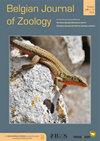Changes in prey importance and prey niche overlap of sexes during the alpine newt breeding season
IF 1.1
4区 生物学
Q2 ZOOLOGY
引用次数: 0
Abstract
Urodeles, including European newts, are usually sexually dimorphic predators. Among newts, the alpine newt has the most pronounced sexual size dimorphism (in favour of females). Gender is a factor that is often associated with intra-specific diet differences. Despite the significant number of dietary studies on the alpine newt, some topics such as the breadth of the trophic niche and its overlap between sexes, or inter-sexual differences in qualitative and quantitative composition of prey remain unresolved. The present study dealing with these questions was conducted at two localities (ponds at an elevation of about 450 m) in the Czech Republic. Newts were captured from the banks during the entire breeding season using a dip net, and the stomach contents were extracted using a stomach flushing technique. Altogether 190 individuals were sampled, and a total of 1,417 prey items were obtained. The available food sources differed over the course of the breeding season, as newts changed the taxa they preyed on. This reflects the ability of newts to switch between several hunting strategies. The overall food niche overlap between the sexes was relatively large (C = 0.761, resp. C = 0.797). Inter-sexual differences were detected at both localities, mainly in the number of prey items consumed from the most important prey categories such as Rana eggs or Isopoda, which were consumed in higher numbers by females. The findings of this study suggest that females are more sensitive to the trade-off between energy intake and expenditure during the breeding season.高山蝾螈繁殖季节猎物重要性和猎物生态位重叠的变化
尾螈,包括欧洲蝾螈,通常是两性异形的捕食者。在蝾螈中,高山蝾螈具有最明显的性别大小二态性(有利于雌性)。性别是一个经常与特定饮食差异相关的因素。尽管对高山蝾螈的饮食进行了大量的研究,但一些主题,如营养生态位的宽度及其在两性之间的重叠,或在猎物的定性和定量组成方面的两性差异,仍未得到解决。目前处理这些问题的研究是在捷克共和国的两个地点(海拔约450米的池塘)进行的。在整个繁殖季节使用浸网从河岸捕获蝾螈,并使用胃冲洗技术提取胃内容物。共采集190只,捕获猎物1417只。随着蝾螈捕食种类的改变,它们在繁殖季节的食物来源也有所不同。这反映了蝾螈在几种狩猎策略之间切换的能力。两性食物生态位总体重叠较大(C = 0.761, p < 0.05)。C = 0.797)。在这两个地方都发现了两性间的差异,主要是在捕食最重要的猎物种类(如蛙卵或等足目动物)的数量上,雌性捕食的数量更多。本研究结果表明,雌性在繁殖季节对能量摄入和消耗之间的权衡更为敏感。
本文章由计算机程序翻译,如有差异,请以英文原文为准。
求助全文
约1分钟内获得全文
求助全文
来源期刊

Belgian Journal of Zoology
生物-动物学
CiteScore
1.90
自引率
0.00%
发文量
10
审稿时长
>12 weeks
期刊介绍:
The Belgian Journal of Zoology is an open access journal publishing high-quality research papers in English that are original, of broad interest and hypothesis-driven. Manuscripts on all aspects of zoology are considered, including anatomy, behaviour, developmental biology, ecology, evolution, genetics, genomics and physiology. Manuscripts on veterinary topics are outside of the journal’s scope. The Belgian Journal of Zoology also welcomes reviews, especially from complex or poorly understood research fields in zoology. The Belgian Journal of Zoology does no longer publish purely taxonomic papers. Surveys and reports on novel or invasive animal species for Belgium are considered only if sufficient new biological or biogeographic information is included.
 求助内容:
求助内容: 应助结果提醒方式:
应助结果提醒方式:


